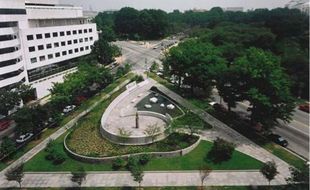Unseen, Yet Ever-Present: Intention
Memorials are a society’s way of recognizing groups or individuals, allowing their marks in history to manifest themselves in a physical manner. Memories reside within these structures, so that those who take respite nearby may be imbued with appreciation and respect for the past. This allows the public as a whole to remember the impacts and struggles of the commemorated.
Subsequently, the manner in which memorials preserve memories is of critical importance. Inaccurate portrayal can lead to misunderstandings, causing an erroneous public perception which undermines the primary purpose of a memorial. If a memorial is to be true to history, there can be no leeway when deciding its depiction. As a part of the decision making process, the intention behind a memorial becomes an integral part of the memorial itself, for it is what drives choices in every aspect. It can be a potentially fatal one, at that, since oftentimes intention goes unperceived in the memorial itself. Care must be taken, then, in not only choosing the presentation of the memorial itself, but also in determining with what intentions a memorial is to be designed. Intentions will always be reflected, and the most genuine of them make for the most accurate, impactful memorials.
Memorials that commemorate locally celebrated history have a relatively easy time with this. Small communities usually don’t have enough resources to easily leverage a memorial. One doesn’t come to be without a significant portion of the community sharing a common respect that all feel is worthy of commemoration. When memorials are built within these environments, they are often fit for those they remember, since there is nothing more behind it than genuine appreciation. The Pomeranian Granite Memorial is an excellent example of the spirit captured by such locally celebrated memorials.
Problems begin to arise whenever the scope of the memorialized begins to grow, however. The larger the population that is concerned with it, the easier it is to create a memorial without such a unification of intention, since there are simply more resources to go around. This problem is further compounded by the fact that issues with larger scopes oftentimes have more facets to them. What one subsection of the population may view in one particular light, another may see reflected in another manner.
One potent example of this is the National Japanese American Memorial to Patriotism During World War II. Its intentions started out sincere, as a memorial to Japanese American veterans (Niiya, 2017). Whenever legal objections were raised to the subject of the memorial, however, it was re-imagined to the compromise that it is today: an indirect reference to Japanese American veterans permitted by the use of the word “Patriotism” (Niiya, 2017).
Though this could be viewed as the correct decision, since it still allowed the construction of some form of memorial honoring the contributions of Japanese American veterans, its practical implications were profound. Primarily, the use of the term “Japanese American” can make it seem that it is a memorial that applies to the whole population of Japanese Americans, including those that suffered in internment camps. When this is understood alongside the word “Patriotism”, the result is that the name can be misunderstood to be a selfish “thank you” on behalf of the nation in a situation where a sincere apology for terrible history would be more appropriate. In this lense, Japanese American pain only seems to be acknowledged for their servitude of our nation, not because the unjustified suffering alone is enough to warrant some form of reconciliation. The perspective that this cultivates is one that risks loss of appreciation for cultures besides our own. Despite this controversy and more, however, the scale of the project allowed it to raise enough funds to bring it to fruition (Niiya, 2017). Thus, the masking of the intention of the creators creates the potential for misunderstandings to propagate.
This isn’t to say that memorials of national scope are entirely impossible to create correctly, however. In contrast to the National Japanese American Memorial to Patriotism During World War II, there exists the Soul Consoling Tower. Its origins are much more exclusive and unifying to the group it is concerned with. Created by the Japanese American internees who wanted a way to commemorate their dead, they spent what few cents they had to purchase materials to make the monument a reality (“Manzanar Cemetery”, 2009). Long after the internment camp has ceased to exist, the tower remains. It is not an extravagant monument - it is absent of magnificently poetic depictions of suffering and is instead just a simple geometric form. It did not leverage thousands of dollars. Yet, despite all of this, it remains free of controversy, instead having evolved into a symbol of the national tragedy of the japanese internment camps - a symbol that is worthy of pilgrimages (“Manzanar Cemetery”, 2009). Pure in form and intention, it allows for the propagation of a potent memory that doesn’t need to be enforced via inscription.
Intention is an important, invisible part of every memorial. Allowing the intention of the memorial to be manipulated can cause the resultant symbolism to prove awry. Even if the manipulation was allowed with good purpose, the multi-faceted nature of much of history can allow for incorrect interpretations. The power of a genuine memorial cannot be understated.
Works Cited
Niiya, Brian. "National Japanese American Memorial to Patriotism During World War II." Densho Encyclopedia. 9 Nov 2017, 23:23. https://encyclopedia.densho.org/National%20Japanese%20American%20Memoria....
“Manzanar Cemetery”, Manzanar Store. 2009. http://manzanarstore.com/cemetery.html.






